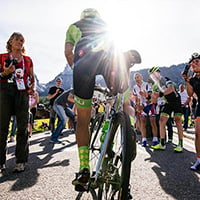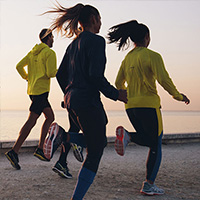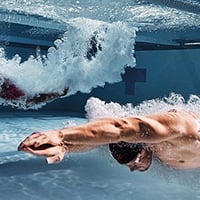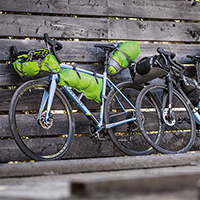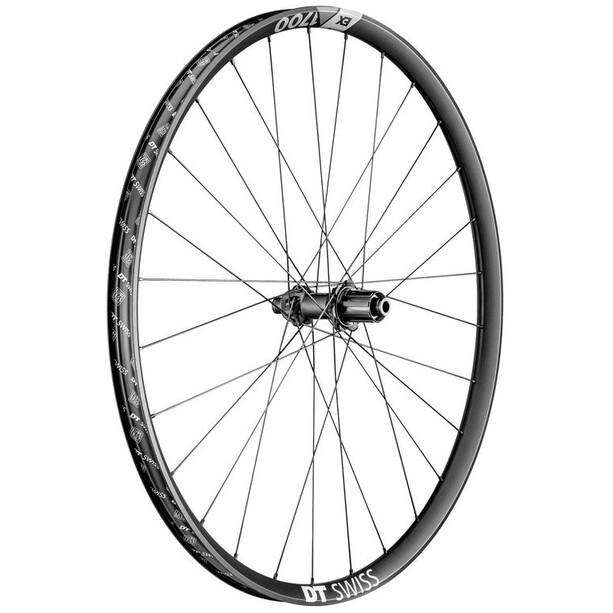Product description
DT Swiss EX 1700 Spline Rear Wheel 29" Disc CL 12x148mm TA Shimano Light 21mm
DT has taken all their aluminium wheel know-how and put it in the high performing package. EX 1700 SPLINE wheels are based on the famous 36t RATCHET hubs combining it with a super strong and welded 30 mm wide aluminium rim. The rim profile is designed to withstand the hardest use of Enduro racing while still keeping the weight low for long and demanding uphills. Laced to double butted competition straightpull spokes, the EX 1700 SPLINE wheels are built to take a beating.
TUBELESS TECHNOLOGY
Tubeless tires offer some decisive advantages over the conventional combination of tire and tube: The tyre can be driven with less pressure without risking "snakebites" and therefore offers more grip. The lower pressure also ensures greater driving comfort. Dispensing with the inner tube means that there is no friction between the tube and the tyre and that therefore the rolling resistance is lower when driving off-road and over obstacles. If tubeless milk is also used, the tyre is also immune to punctures and small cuts. A great advantage for all those who like to ride long distances and away from the nearest bike shop.
The advantages
Tubeless Ready rims from DT Swiss have further advantages over conventional rims. Thanks to the design of their cross-section, the tyre simply pops into place when inflated, so that usually only a normal stand pump is needed. The ingenious tread pattern of DT Swiss rims also ensures that the tyre fits precisely and securely, even under tough driving conditions.
The perfect fit
The profiles of DT Swiss rims are specially designed for tubeless use. They guarantee a perfect fit and make the installation of the tyre as easy as possible. Nevertheless, it is always possible to use a conventional combination of tire and tube.
DT Swiss valve
The use of aluminium saves 40% weight compared to conventional brass valves. The integrated valve tool in the valve cap saves time and effort in finding the right tool for removing the valve insert. The conical valve base ensures a tight fit. The DT Swiss Tubeless valve fits perfectly to DT Swiss rims and ensures a perfect seal for long trouble-free rides.
DT Swiss tubeless band
The DT Swiss Tubeless Ready Tape seals the rim and also functions as rim tape. It is available in different sizes to fit perfectly to the different inner widths of the rims.
The DT Swiss tubeless ready kit
The DT Swiss Tubeless Ready Kit is used to seal the Tubeless Ready rim and thus enables tubeless riding. DT Swiss strongly recommends the use of a high performance tyre sealant even when using tubeless specific tyres. When using Tubeless Ready tyres, the use of the sealant is mandatory (the sealant seals the tyre, which is primarily not airtight). A tubeless structure reaches its full potential only with a sealant! Make sure that the sealant is compatible with the rim, rim tape and tyre. It must not be corrosive or aggressive in any way. If in doubt, contact the sealant manufacturer so that you do not lose your DT Swiss warranty.
PRO LOCK TECHNOLOGY
Pro Lock is a process where a patented, dual compound, adhesive liquid is injected into the nipple thread, allowing for extremely durable wheel builds. By threading the nipple onto the spoke the adhesive is activated and starts to harden. Retruing the wheel is still possible after the adhesive has hardened completely, with only a minimal decrease of its thread-lock function.
PRO LOCK – FACTS
DT Pro Lock nipples prevent the spoke-nipple connection from loosening.
Wheel durability improves up to 20 times compared to non Pro Lock builds.
Suitable for either hand or machine built wheels. Use of grease or oil not recommended.
All DT Swiss nipples are available with and without DT Pro Lock.
PHR – PRO HEAD REINFORCEMENT SYSTEM TECHNOLOGY
The PHR system increases the load-bearing surface of the nipples on the rim and reduces localized stresses. Peak loads are reduced allowing DT to built the rim even lighter. The washer's shape also acts as a ball joint and automatically aligns the specific DT Squorx Pro Head ball head nipples with the spoke further, reducing the risk of spoke failure or rim cracking.
ENGAGEMENT ANGLE TECHNOLOGY
A hotly discussed topic in the market right now - engagement angle! What is the engagement angle, how does this angle affect riding performance and is the conventional wisdom "the more the better" really always better?
ENGAGEMENT ANGLE
The engagement angle is the maximum degree that the freehub body can rotate until the teeth of the freewheel system engage and accelerate the hub. This angle is calculated by dividing 360º by the number of engagement points of the freewheel system.
RIDING EFFECTS
Now that DT knows what the engagement angle is, the question is when and how does this angle affect riding?
BACKLASH
The backlash - is the maximum idle distance the crank can turn before the freewheel mechanism engages and converts the force on the crankinto acceleration of the wheel. The backlash is influenced by three factors, the crank length, the gear ratio and the engagement angle.
The crank length and the engagement angle are proportional to the idle distance of the crank. The gear ratio, on the other hand, has an inversely proportional effect on the backlash.
The smaller the gear ratio, the greater the maximum idle stroke of the crank.
So when is a small backlash important? When it comes to climbs and situations where it is important to accelerate immediately to overcome obstacles.
PEDAL KICKBACK
Pedal kickback is a phenomena that only appears on full suspension bikes. It is caused by chain tension during suspension compression, which leads to a backwards movement of the cranks. Additionally, this chain tension prevents the suspension to move freely. But what does pedal kickback have to do with engagement angle?
To describe the effect in more detail, DT first makes two assumptions. The rear wheel is fixed and can neither turn clockwise nor counterclockwise. The second assumption that is made is that DT are in a static situation, which means that they leave the speed of the bike out.
So what happens if the rear suspension compresses?
The rear shock of the bike compresses.
The rear wheel moves around pivot point.
The distance between the bottom bracket and the rear wheel axle changes. This would not happen if the pivot point of the rear swing arm was exactly on the bottom bracket.
This causes the chain length to change, which causes the crank to rotate backwards.
What's the influence of the suspension?
If the crank is prevented from turning, the chain tension keeps the distance between bottom bracket and rear axle constant which in turn avoids the swing arm to move freely and the suspension is not able to absorb the impact.
PEDAL KICKBACK
ENGAGEMENT ANGLE
What does pedal kickback have to do with point of engagement? To understand the influence of the engagement angle on pedal kickback, it is easiest to first look at the two extremes, instant engagement and no engagement.
INSTANT ENGAGEMENT
Instant engagement would be achievable with a freewheel system that offers an infinite number of points of engagement (POE). In any situation where your freehub body might be, the freewheel body is engaged in the hub housing. The freehub body can rotate counterclockwise, but cannot move clockwise. When the suspension is compressed, the distance between bottom bracket and rear axle increases (in dependence of the respective bike kinematic). The change in chain length is thereby compensated by the derailleur or the chain tensioner. Since the freehub body can only move counterclockwise, the chain is tensioned backwards, what causes a backwards movement of the cranks too. If the cranks were fixed, a change in distance between bottom bracket and rear axle would not be possible, what would avoid free movement of the suspension.
NO ENGAGEMENT
The other extreme would be a freewheel system without any POE, which would mean that the freehubbody could rotate freely in both directions. With this starting position, the freewheel body can now also move in a clockwise direction. Even if the crank is now fixed by the rider's body weight, the rear end could work freely, since the chain can move clockwise over the cassette.
EXAMPLE PEDAL KICKBACK
Let's assume that a bike has a pedal kickback of 3° at an impact of 50 mm with a gear ratio of 32/14. What does this mean for the freewheel? To understand the influence of the engagement angle on the pedal kickback, you need to know how much the freewheel would turn. To do this, one multiplies the pedal kickback by the gear ratio.
3° on the crank, means a 6.8° rotation of the freewheel body.
In a system without any POEs, the freewheel body could rotate freely by the appropriate angle in any position, and there would never be any pedal kickback. In a system with infinite POEs or with a high amount of POEs, there is a high probability of pedal kick-back. In regard to the example this means, that if the engagement angle is smaller than 6.8°, there is a high probability for pedal kickback. The larger the engagement angle, the lower the probability for pedal kickback.
More points of engagement = higher potential of pedal kickbacks
ADDITIONAL REMARKS
While riding, the hub rotates at a certain speed. To accelerate, the freewheel body has to engage with the hub and this only occurs if the cassette rotates faster than the hub. In case that the angular speed of the hub is faster than the angular speed of the cassette, the freewheel body cannot engage and the wheel would not accelerate.
For pedal kickback, this means that if the angular speed of the hub is higher than the speed of the freehub body generated by the chain tension, there would be no pedal kickback or negative influence on your suspension. But it is not easy to reach this critical speed, because the faster you ride, the higher the possibility of harder compressions and the faster the freewheel body speed reached by the chain. If it were easy to reach this speed, there would be no world cup riders that experiment with removing a sprocket to have an idle to eliminate pedal kickback.
However, it should also be noted that the kinematics of some bikes have no pedal kickback.
CONCLUSION
In the development of an optimal freewheel system DT believes that three factors have to be considered: reliability, weight and points of engagement. But you must bear in mind that there is a trade-off between all of these three dimensions. Plus l’angle d’engagement est petit, plus le système de roue libre doit être gros afin d’assurer le même niveau de fiabilité qu’avec un système ayant moins de points d’engagement. If DT were to introduce a system with more points of engagement DT would need to enlarge the construction of the hub what eventually would lead to a significantly higher weight.
However, rather than minimizing the engagement angle, the overall performance of the system must be maximized. DT still believes that a system with 36 points of engagement represents the best optimization within this three dimensional perspective in terms of reliability, weight and points of engagement.
RATCHET TECHNOLOGY
LEGENDARY RELIABILTY
The patented freewheel system, which features high-precision star ratchets, guarantees top performance and reliability. The simultaneous engagement of the ratchet teeth makes the Ratchet System extremely reliable since the loads are distributed equally across a large contact surface.
NOTOOL CONCEPT
The plug-in construction of the Ratchet system hubs allows for quick and tool-free maintenance.
FREEHUB BODY CONVERSION
The no-tool concept allows the conversion to a different drivetrain standard within seconds.
Details
- ASTM classification: 4
- Freewheel body Shimano light (ASL)
- Freewheel system: Ratchet System 36 SL






























